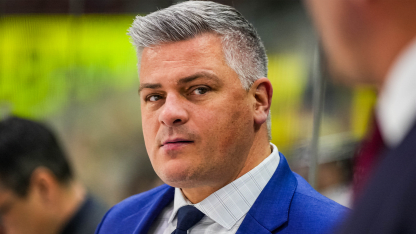
Sheldon Keefe wasted no time finding a new home after parting ways with the Toronto Maple Leafs in early May. A couple of weeks later, on May 23rd, he officially landed another coaching job with the New Jersey Devils. It’s a fresh start for Keefe, and many are betting he’ll fare much better this time around as an NHL head coach.
One thing Keefe will notice right off the bat is the similarity between the Devils and his former team, the Leafs. Like in Toronto, New Jersey’s success hinges on having reliable netminders between the pipes. Keefe knows this all too well, and with a shiny new four-year contract in hand, he’s counting on GM Tom Fitzgerald to shore up the goalie situation. Yet it’s also a system Keefe employs, which partially affects how his players perform. So, with that in mind, let’s dive into his tactics, which can propel the Devils in their quest for the young core to leap towards becoming a Stanley Cup contender.
Offensive Zone:
Let’s break down Keefe’s playing style in the offensive zone, starting with the “uphill” approach. Picture forward Nico Hischier grabbing the puck and moving below the goal line, scanning for potential pass opportunities. Timo Meier would position himself before the goalie, ready to receive a pass. And then you have Jesper Bratt hanging out down low, serving as another option for Hischier’s pass.
Here’s the catch with this setup: it’s excellent for creating chances, but it only gives the defensemen a little room to get in on the action. If Hischier’s pass doesn’t quite hit the mark, there’s a good chance it will leave the zone altogether.
There’s a silver lining. They also have a “downhill” play in their playbook, which will probably be used more often. This time, excellent movement starts from the top of the offensive zone and flows down toward the goal line. It’s a switch-up from their uphill strategy, but it plays to the strengths of their blue-line players, who are skilled at getting involved in the offense.
So, while their uphill approach has drawbacks, the downhill style is more catered to playoff hockey. However, both are needed, and Net Jersey must find the right balance and adjust to keep the game flowing in their favor.
Neutral Zone:
When Keefe’s squad is on the attack in the neutral zone, they layer their players strategically.
One of their defensemen usually starts with the puck when they’re breaking out from their defensive zone. Then, their forwards line up in three layers across the neutral zone. The F1 hovers near the blue line closest to their DZ, F2 hanging out near the red line by the end boards, and F3 chills near the opposing blue line, ready to dart across the ice for a pass. If this sounds familiar, Peter Laviolette’s Presidents Trophy-winning New York Rangers, who are two wins away from the Stanley Cup Final, used the trap to sweep the Devils 4-0 in the regular season this year, provided it’s what they were missing in the Hudson River playoff series a season ago under Gerard Gallant.
When executed, the defenseman with the puck has a few options: they can dish it off to F1 to end boards a breakout rush, try to thread a pass to F2, or hit the F3 if they’re open for a breakaway.
Now, let’s flip the ice and talk about defending a breakout in the NZ. Keefe’s teams like to use a classic 1-3-1 neutral-zone trap. Picture F1 skating closest to the puck while two other players collapse on the breakout (usually F2 or F3 and a defenseman). And if the breakout player manages to slip past the trap, there’s always a defenseman waiting to step up and defend that 1-on1 situation.
If they cannot set up the 1-3-1 trap fast enough, they’ll switch gears and shift into a 1-2-2 formation to cover their bases.
With the Devils’ knack for creating takeaways in the neutral zone thanks to stars like Jack Hughes, they should be able to execute Keefe’s system with finesse. We may even see them take it to the next level compared to the Toronto Maple Leafs.
Defensive Zone:
One thing that eagle-eyed fans have noticed about Keefe’s Maple Leafs is their deliberate approach once they gain possession of the puck. Unlike some teams that rush to move the puck up the ice, the Leafs take their time and play it safe.
Instead of risking a turnover by throwing the puck into the middle of the ice after winning a battle along the boards in the zone, they prefer to work the puck from side to side or pass it off to a defenseman down low.
This strategy helps minimize turnovers in the defensive zone but also means they’re less likely to generate bran rushes the way. On the flip side, Lindy Ruff’s system with the Devils was all about speed and aggression. They were willing to take more risks, even if it meant occasional turnovers in the slot. The Buffalo Sabers are about to experience this now.
This new approach under Keefe should help keep New Jersey goaltending from getting hung out and dry as often, which is excellent news for the Devils. Instead of rushing to exit the zone after a board battle, the player who comes out on top takes a moment to assess their options before making a move. It’s a safer play than clearing the puck and hoping for the best. And considering how much the Devils struggled defensively last season, this change couldn’t come soon enough. They’ll need to focus on executing these defensive strategies flawlessly if they want to avoid a repeat of missing the playoffs.
Why Keefe is a better fit for the Devils than Berube:
Let’s switch gears and delve into Craig Berube’s system and how it compares to what the Devils are getting in Keefe. The Devils might sigh with relief that they don’t have Berube at the helm, while the Maple Leafs do.
Berube’s teams are all about that old-school, dump-and-chase, gritty play in the offensive zone. It’s the kind of hockey where you’re not afraid to get your hands dirty in the corners. To his credit, it worked in 2019 when the St Louis Blues hoisted the Stanley Cup. Yet one can argue that the system is becoming outdated by the year.
When his squad is on the attack, they’re not necessarily looking for those smooth, controlled entries as you’d see from players like Jack Hughes or William Nylander. Instead, they’re all about crashing the net and creating chaos in the corners.
For their forecheck, one forward (let’s call him F1) dives deep into the corner, ready to battle it for possession. If there’s a loose puck, another forward (F2) swoops in to scoop it up. Meanwhile, F3 is hanging back, waiting for a pass to open.
Once they have the puck, they like to set up in a 2-1-2 formation, with two forwards down low, ready to pounce, and two defensemen holding down the fort at the point.
But Berube’s system often ran into trouble against teams with tight defensive coverage. That’s how teams have played against St. Louis since their cup year, and they’ve never won a series. It became too much to ignore for the Blues brass, leading to his firing, an underwhelming season, and a playoff miss. When you’re all bunched up in the low cycle, finding those openings in the defense takes a lot of work.
To shake things up, Berube sometimes tweaked the formation, shifting more players to one side of the goal to create a makeshift 2-on-1 situation. The Maple Leafs may benefit from Berube’s style because their rush-centric players need to be shown how to play workmanlike hockey. The young Devils must be taught how to balance the differing play styles and when it’s okay to play safe hockey.
But why wouldn’t Berube’s system fit the Devils well? Well, it all comes down to their style of play. Players like Hughes, Jesper Bratt, and Hischier thrive in fast-paced, rush-style offenses, not necessarily in the grind-it-out, dump-and-chase game.
So, while Berube’s style might have its merits, it’s safe to say the Devils are better off sticking with Keefe for now.

ITR 47: Then There Was Nothing – Inside The Rink
Discover more from Inside The Rink
Subscribe to get the latest posts sent to your email.



